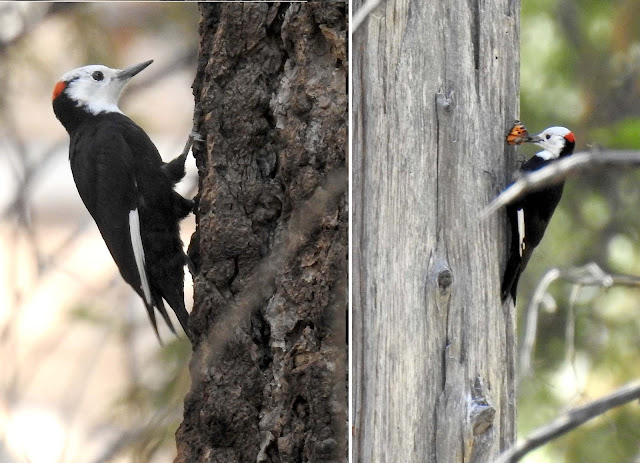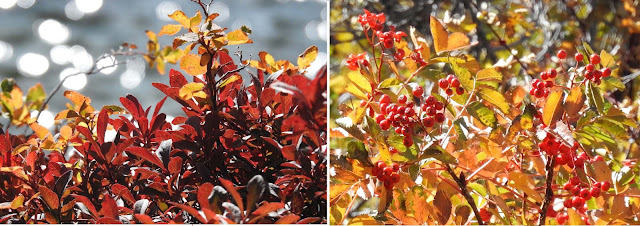Wind-stripped willows on the North Yuba River
This week the wind was blasting and the power was out for 6 days! Although it was somewhat of an inconvenience to be without power, it prevented wildfires from starting! Winds reached approximately 60 miles an hour up at Yuba Pass!! Trees toppled, branches broke off, and leaves were stripped by the wind. The humidity dropped to 19%, but is currently back up to 35%. Hopefully we'll get some rain in the near future, and no more wind. Fingers crossed!
A lot of the fallen leaves have collected in the shallow areas along the river's shore. They look like thick brush strokes in a Van Gogh painting! I love how they show the flow of the water. What a beautiful river of leaves!

Oriole nests before and after the Wind
Now that the leaves are gone from the trees, lots of bird nests are visible. These nests were made by the same oriole over the past three years! It is amazing to me that these bird nests, as well as many others, are so well-constructed that they can withstand 35 mph winds, rain, snow, and freezing temperatures for years!
El Capitan
Yosemite National Park
The following history of Yosemite National Park is from the website myyosemitepark.com.
"President Abraham Lincoln signed the Yosemite Land Grant into law in 1864, giving the Yosemite Valley and the Mariposa Grove of giant sequoia trees to the state of California. Galen Clark was appointed Yosemite's first Guardian, a position held for most of the next 35 years.
But state protection of Yosemite Valley and the giant sequoia grove was not enough for conservationist John Muir. In 1868, Muir walked from San Francisco Bay to the Yosemite Valley. Inspired by the natural beauty he found there, Muir soon started writing about Yosemite in magazines and newspapers that reached audiences across the USA.
Muir's writing and his own personal passion for Yosemite and the Sierra Nevada helped spur a national conservation movement. Muir even escorted groups of influential people on guided trips into Yosemite and the surrounding Sierra Nevada to expound upon the importance of preserving nature. On one trip to Tuolumne Meadows, Muir together with Robert Underwood, editor the Century Magazine, came up with the idea to launch a campaign to make Yosemite a national park.
Their dream came true in 1890, when the land around Yosemite Valley and the Mariposa Grove of giant sequoias became part of Yosemite National Park. Congress also authorized the creation of Sequoia National Park and General Grant National Park (now part of Kings Canyon National Park) to preserve the giant sequoia forests found farther in the Sierra Nevada. The U.S Cavalry assumed jurisdiction of the new national park lands.
But exploitation of the new national park's resources was still rampant, and the Yosemite Valley itself was still under state control. When Muir took President Theodore Roosevelt on a camping trip in Yosemite in 1903, he was able to convince the president of the importance of preserving more of the Sierra Nevada as federal land. Yosemite National Park as we know it today took shape in 1906, when Roosevelt took back control of Yosemite Valley from the state of California and protected the entire region as Yosemite National Park."

Black Oaks - Quercus kelloggii
I am so thankful for our National Parks! We are so lucky to have these incredible natural areas preserved for us to experience! The first time I visited Yosemite National Park I was only 6 years old! My family and I went on a National Park Ranger/Naturalist walk while we were there and I was immediately smitten! I decided then and there that I was going to be a Park Ranger when I grew up, and I did!!! In the 80's I worked year-round for 6+ years as a permanent Ranger/Naturalist in Sequoia National Park! It was one of the best times of my life! It instilled a permanent love of nature in me that continues to bring me much joy today!
Yosemite Valley meadow
Last week I went to Yosemite National Park with some friends! We visited Yosemite Valley and the Mariposa Grove of Giant Sequoias. It was so incredibly beautiful! I hadn't been to the valley in 25 years! The massive granite walls were spectacular and the Black Oaks were in gorgeous fall color! Even the dry meadows were beautiful in burnished gold and copper! We walked for several hours on the valley floor, enjoying the spectacular views!
Giant Sequoias - Sequoiadendron giganteum
The Giant Sequoias were indescribably beautiful! These giants are the largest living trees, by volume, on earth! They are around 275' tall, with a diameter of up to 100' at their base! They vary in age from an estimated 1,800 years to a documented 3,200 years! They were just spectacular! It was wonderful to walk amongst them again!
Pileated Woodpecker (male) - Dryocopus pileatus
Yosemite Wildlife
We saw several kinds of woodpeckers in Yosemite. Apparently they have been attracted to the wood-boring beetles that have killed a lot of the conifers. Right now the Park Service is cutting down a lot of these dead trees, as they are a fire hazard. I'm assuming the woodpeckers population will decrease once the beetles have been depleted.
I wrote about these beautiful woodpeckers last year. The following information is from my October 24, 2018 blog.
Pileated Woodpeckers (above photo) measure 16"-19" in length, are the largest woodpeckers in most of North America! They live in coniferous forests from 2,000'-7,5000'. They are non-migratory birds, and live year-round in their chosen habitat. The name pileated comes from the Latin word "pileatus" meaning "capped", and refers to their red crest. The one we saw was a male. Females have a red cap, but not as extensive, and do not have a red stripe on the side of their head. Males and females usually pair for life, and will defend their territory year-round. At night they will roost singly, or with other species of "roosters", in tree cavities!
Pileated Woodpeckers peck tree trunks and stumps to find their prey of carpenter ants and wood-boring beetle larvae. They will also eat grasshoppers, termites, cockroaches, flies, fruit, and nuts. Their tongues are long, sometimes 4" in length, sticky, bristled, and recessed back over the top of their skull when not in use!!! These long tongues are used to retrieve insect prey from inside the trunk of a tree. When searching for prey they usually peck 20 times per second, with a total of 8,000 to 12,000 pecks per day!!! Their skull is structurally reinforced to spread the impact force of constant pecking, and is composed of strong but compressible sponge-like bone. To prevent the movement of the brain during pecking, their brains are surrounded with minimal cerebral fluid."
Hairy Woodpecker (male) - Acorn Woodpecker (male)
Dryobates villosus - Melanerpes formicivorus
Hairy Woodpeckers eat insects, fruit, berries, seeds and even sap! Acorn Woodpeckers mainly eat acorns but will also consume insects, berries, and sap!
White-headed Woodpecker (male) with California Tortoiseshell Butterfly
Dryobates albolarvatus - Nymphalis californica
White-headed Woodpeckers eat some adult insects, but mainly eat the seeds from pine cones! Unlike most woodpeckers, they do not drill into tree trunks to get insect larvae!

California Mule Deer - Odocoileus hemionus californicus
We saw a few Mule Deer in the sequoia forest. They were really camouflaged and hard to discern from the dry branches and leaves on the forest floor.
Lodgepole Chipmunk - Douglas Tree Squirrel/Chickaree
Tamias speciosus - Tamiasciurus douglasii
We saw several chipmunks and squirrels in the Sequoia forest. The chipmunks will hibernate over winter, but the Chickarees will remain active living off of food caches.
Aspens - Red Osier Dogwood - Aspens & Dogwood
Populus tremuloides - Cornus sericea
Lakes Basin Fall
Two weeks ago I went for a hike with my friend BJ up in the Lakes Basin. The fall color was spectacular! The Dwarf Bilberry was a brilliant raspberry color, the Quaking Aspens were a gorgeous golden yellow, the Red Osier Dogwood was deep maroon to peach, and the Spirea was bright yellow to a deep rust in color! Just exquisite! I'll be going back up there this coming week, and I'll let you know if there's any fall color left after the recent wind.
Dwarf Bilberry & Mountain Spirea - Mountain Ash
Vaccinium caespitosum & Spiraea densiflora - Sorbus californica
It was another clear, blue-sky day in the Lakes Basin, with sparkles on the water!

Dwarf Bilberry & Mountain Spirea
Vaccinium caespitosum & Spiraea densiflora
The wild carpets of Dwarf Bilberry bordered by Mountain Spiraea were stunning!
The Pink Cliffs
We hiked cross-country in the Long Lake area, and transversed an area we have named the "Pink Cliffs". Unfortunately on the way back to the car, my friend BJ tripped and fell on one super-rocky section of the trail!!! Luckily she didn't break anything, only got a gash on her left shin that she bandaged up, and was able to hike out! Sheesh! It could have ended up a LOT worse! Be careful when you're out there and be prepared for emergencies!
What birds are migrating through our neighborhood?
Where are the Bears?
What are the Herps doing?
Check back next week for the answers to these questions and more!
If all of a sudden you haven't been getting email notices of my blog being published, just sign up again on my blog. I don't know why you got "unsubscribed". It's some kind of problem with Blogspot.com and/or FeedBurner.com. I apologize for this glitch!
Your questions and comments are greatly appreciated!
Please email me at northyubanaturalist@gmail.com












No comments:
Post a Comment